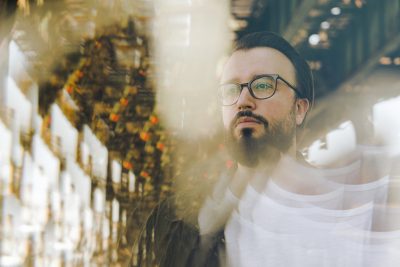'Event Horizon' at Tina Kim Gallery
At Davide Balliano’s ‘Event Horizon,’ system error is the point
A Kubrickian exhibit of paintings and sculptures owes more to the Renaissance than Op art
“Event Horizon,” the latest solo show by Brooklyn-based artist Davide Balliano at Tina Kim Gallery in Chelsea, gets its name from the surface of a black hole. It’s the scientific term for the point of no return — anything beyond will inevitably get sucked in.
Painted arches and perfect circles across the show form otherworldly vortexes in Balliano’s signature black-and-white color palette. Compact, abstract sculptures accompany these paintings, with ample physical space between each. Pops of rusty red marble offer the only color in the room. And yet, Balliano’s paintings and physical forms don’t feel separate. Even the works on the wall use plaster and gesso like sculpture.
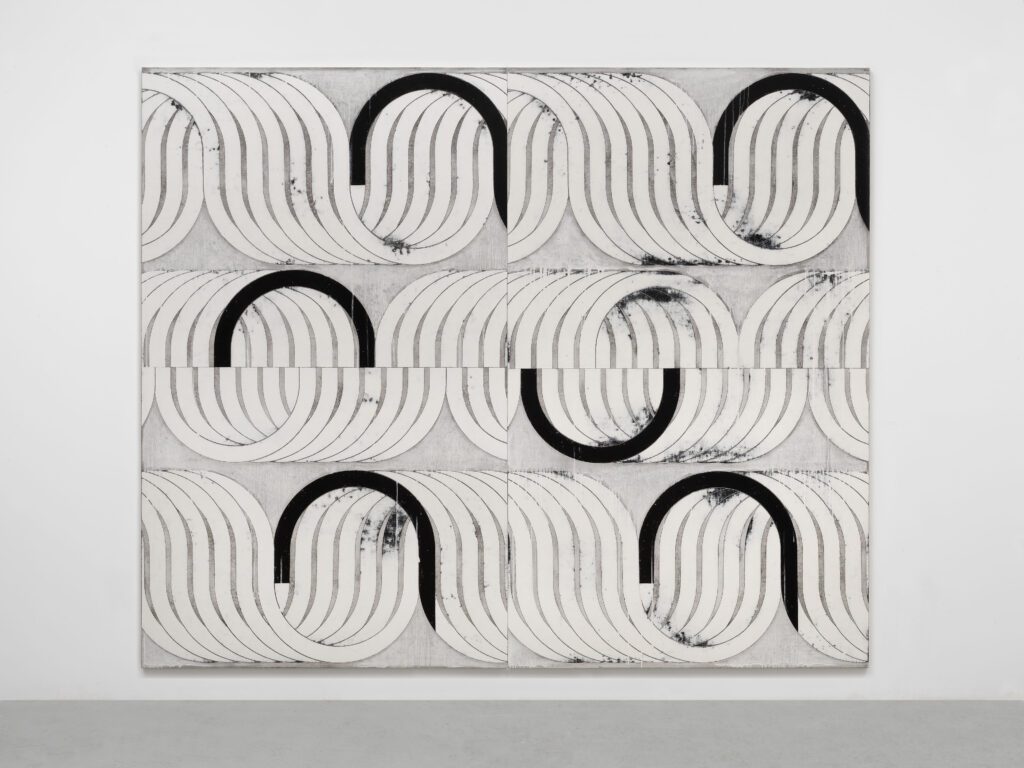
‘UNTITLED_0247,’ 2022, Davide Balliano (Courtesy Tina Kim Gallery)
At first glance, those paintings look like optical illusions, but that is itself an illusion. Balliano takes more inspiration from the architectural ruins of Renaissance Italy than from the Op art that may come to mind.
“Event Horizon” is Balliano’s fourth exhibition with renowned dealer Tina Kim. Born in Turin, Italy, in 1983, he left home to study photography in Milan. Upon completing the Benetton group’s Fabrica residency at age 22, he planned to practice commercial photography while exploring creatively on the side.
“That felt immediately quite unrealistic,” Balliano tells Brooklyn Magazine in the back room at Milk and Roses in Greenpoint — days after his first daughter’s birth. In Italy, he assisted famed fashion photographers like Aldo Fallai on editorial shoots, and saw stars like Giorgio Armani in action.
In 2006, Balliano moved to New York. “I wanted a change from Europe but also wanted to get out of photography,” the artist says. He spent a year living in the “perennial darkness” beneath the Myrtle-Broadway J/M/Z stop before seeking quiet in Brooklyn’s northernmost neighborhood, where he still lives, while working out of an airy, spartan Bed-Stuy loft since 2019.
Even if photography was no longer his bag, Balliano valued his time apprenticing so much that he arrived stateside with a “shopping list” of visual artists he wanted to assist. He ended up spending four lucky years coordinating logistics for performance artist Marina Abramovich — up through 2010, just before Abramovich’s legendary MoMA show “The Artist Is Present” turned her into a household name.
Grants and residencies powered Balliano’s leap while he worked at mastering new crafts. For the first two years, the artist experimented by printing out black and white photos of astronauts, animals, architecture and more — even tearing pages out of art history books — then “intervening” by drawing atop them in black and white. “After a while the interventions were getting bigger,” Balliano says. “The image in the background started to feel like a burden.” Next he tried altering images of Orthodox Christian icons depicting saints, seeking commune with spirit. “I failed miserably,” Balliano recalls. “The compositions were really perfect as they were.”


‘UNTITLED_Rosso Agadir,’ 2023, Davide Balliano (Courtesy Tina Kim Gallery)
From there, Balliano began focusing instead on those icons as sculptural objects. They often feature frames carved in relief, with imagery painted into them. His icons, however, were left blank and monochrome, emphasizing their materiality. They grew thicker, until they morphed into the sculptures on view in “Event Horizon” — carved notably, here, from Carrera marble. The show presents Balliano’s first time working with this material, which blends both the exacting and organic natures of his former favorites, stainless steel and ceramic. Those early works led Balliano into painting arches too, then pushing them further by splitting them in half, flipping and twisting the arches into patterns.
Until 2015, Balliano left his 2D works untitled and gave his sculptures intricate names. Then he began labeling them all with an online random number generator, in the interest of archiving. “That lasted a few months,” he says. He’s numbered works chronologically ever since, starting from 011 rather than 001 to relieve that first work of pressure — and commodification. This system also mimics how we name celestial bodies.
“Repetition is a tool for me,” Balliano says, and “something I trust in guiding where the work goes.” Admirers watching his practice grow might someday be able to guess what any work looks like based on its title, its number, alone.
Each successive gallery exhibition shares a new chapter in Balliano’s practice, which is expanding steadily (just like our universe itself). He typically works on his canvases while they’re flat on the ground. Painting arches like this demands his full wingspan — a disciplined labor he traces back to Abramovich. While preparing works last year for his first solo show in Milan, though, Balliano tried standing his canvases upright while wet, letting contrasting paint drip beyond the bounds of his precise brushstrokes. “Event Horizon” allows his linework to break apart even further. Here his arches quietly begin to lose their resolute paths, as if glitching.
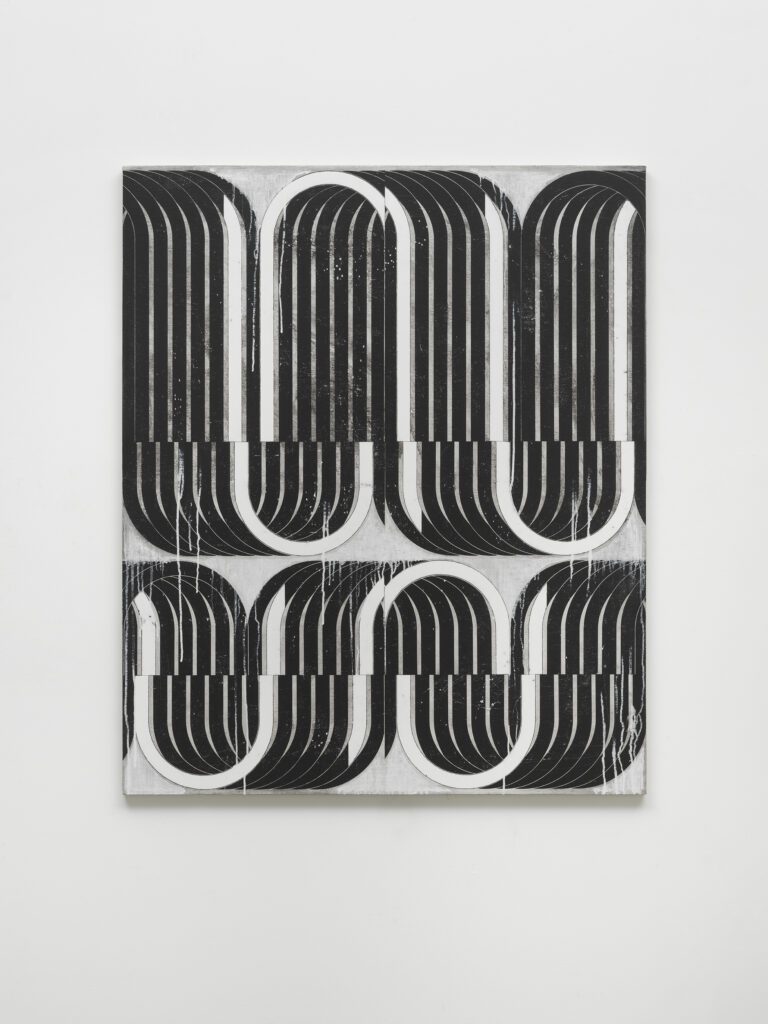

‘UNTITLED_0272,’ 2023, Davide Balliano (Courtesy Tina Kim Gallery)
“When the system error finds its way into the general harmony, that kind of expanding and re-plotting I find interesting,” he says. Think of Merry Clayton’s breaking voice or Cindy Crawford’s beauty mark. Imperfection is perfection, and it’s impossible to fabricate, like cracks in the broken marble that Balliano’s selected. He’s tried to simulate randomness before, and failed miserably.
“My hope and desire is that the work sparks thought and introspection,” Balliano says. “Event Horizon” lives up to its name like this, luring viewers deep within. “I don’t look for entertainment, I don’t look for beauty,” he says. “When I look at art, I want to think about relevant questions.”


Courtesy Tina Kim Gallery
Catch it before it’s gone. “Event Horizon” is on display at Tina Kim Gallery until October 7. 525 W 21st St.
You might also like 

















